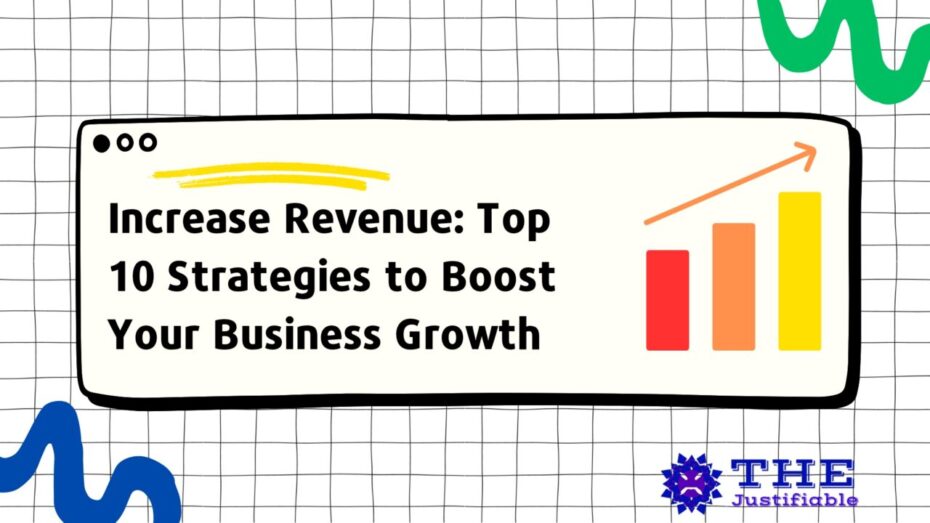Table of Contents
Revenue growth is a vital indicator of a business’s health and its ability to sustain and expand. It’s not just about generating more income, but it’s a testament to a company’s capacity to adapt, innovate, and capture a more significant market share. While many factors determine a business’s success, consistent revenue growth is undeniably at the core.
What does it mean to increase revenue for a business?
When we talk about increasing revenue, we’re delving deeper than just boosting sales. To increase revenue implies a comprehensive enhancement in various facets of a business. This could mean capturing a larger audience, making more sales, or even selling at a higher price point.
But more holistically, it’s about understanding market demands, optimizing offerings, and ensuring that every aspect of the business, from marketing to customer service, works cohesively towards financial growth.
This financial upswing is crucial, not just for the sake of numbers but for what it represents: increased customer trust, a more substantial market presence, and the ability to fund further innovations and expansions.
The direct correlation between revenue growth and business longevity
It’s no secret that businesses that fail to grow or increase revenue over time face challenges that might jeopardize their very existence. But why is this? Well, the direct correlation between revenue growth and business longevity is multifaceted.
Firstly, revenue growth typically indicates a growing or stable customer base. When a business continually attracts new customers and retains the existing ones, it showcases that the company is resonating with its audience, meeting their needs, and is on the right path.
Secondly, with increased revenue, businesses can reinvest in themselves. This could be in the form of research and development, expanding into new markets, or investing in better operational efficiencies. All of these factors contribute to a business’s ability to stay competitive and relevant in ever-changing market conditions.
Lastly, financial institutions and potential investors always have an eye on revenue growth. A company that showcases consistent growth is more likely to secure funding for further expansion or sail through temporary financial crises.
Top 10 Strategies to Increase Revenue and Boost Business Growth
In the business world, growth is more than just a goal—it’s a necessity. To thrive in today’s ever-evolving marketplace, businesses must adopt robust strategies to ensure not just their survival but their dominance.
Increasing revenue, in many ways, is the most tangible reflection of a business’s growth strategy’s effectiveness. Here are two core strategies businesses can implement to see a marked improvement in their revenue streams.
1. Diversify Your Product or Service Offerings
One of the most effective ways to increase revenue is by diversifying what you offer to the market. By expanding your product range, you position your business to cater to a broader audience. It’s akin to casting a wider net in a vast ocean—naturally, you’ll catch more.
But it’s not just about quantity. The quality of these additional offerings is equally, if not more, critical. Introducing complementary services or products can be a game-changer. Let’s say you run a coffee shop.
On top of your signature brews, offering pastries or coffee beans for home brewing can be an excellent way to tap into your existing customer’s additional needs. Such a move does two things: it can increase the average transaction value and solidify your business’s reputation as a one-stop solution, thus drawing in a larger clientele.
2. Optimize Pricing Strategies
Pricing is a critical component in the equation to increase revenue. However, settling on the right price isn’t always straightforward. To effectively increase revenue, businesses must evaluate the current market to understand where their pricing stands in comparison to their competitors. This doesn’t mean undervaluing your offerings, but ensuring that they are competitively priced to reflect their value.
Once you’ve assessed the market, another strategy to consider is implementing tiered pricing or bundling. Tiered pricing caters to different customer segments by offering various versions of a product or service at different price points. For instance, a software company might offer basic, premium, and enterprise versions of their product.
On the other hand, bundling involves grouping related products or services together at a discounted rate. This not only provides value to the customer but also encourages them to spend more. For example, a fitness center might bundle a gym membership with personal training sessions at a lower combined price.
3. Enhance Online Presence
In today’s digital age, having a strong online presence isn’t just beneficial—it’s crucial. The internet is the modern marketplace, and a business’s online visibility directly influences its ability to attract customers and increase revenue. One of the most efficient ways to boost this visibility is by leveraging Search Engine Optimization (SEO) and online advertising.
SEO is more than just inserting keywords into your content. It’s a dynamic strategy that involves optimizing your website, creating high-quality content, and ensuring a positive user experience to rank higher on search engines.
When done right, SEO can position your business at the forefront of people’s searches, making you their first choice. Parallelly, online advertising, especially through Pay-Per-Click (PPC) campaigns, can help target specific demographics, ensuring your ads are seen by those most likely to convert.
Yet, enhancing online visibility is not solely about search engines and advertisements. Social media platforms have become integral for businesses aiming to increase revenue. Through platforms like Facebook, Instagram, Twitter, and LinkedIn, companies can engage with their audience, promote new products, and even provide customer service. This direct line of communication establishes trust, fosters brand loyalty, and drives sales.
4. Offer Loyalty Programs and Incentives
Customer retention is often more cost-effective than acquisition. One of the proven methods to ensure customers keep coming back is through loyalty programs. These programs are designed to reward customers for their repeated business.
For instance, a point-based system where every purchase adds up and can be redeemed for discounts or freebies can be a compelling reason for customers to choose your business over competitors.
But beyond just encouraging repeat purchases, loyalty programs can be coupled with referral incentives. Imagine providing your loyal customers with added benefits if they introduce your business to friends or family.
This dual benefit not only ensures your existing customer’s continued patronage but also leverages their network to attract potential customers, effectively increasing revenue without a significant increase in advertising spend.
5. Expand into New Markets or Territories
Diversification is a fundamental principle of growth, and for businesses, this often means stepping into new markets or territories. But it’s not as simple as just opening a new store or launching a product in a different country. Successful expansion requires thorough research to identify promising markets where there’s a demand for what you offer.
Once a potential market is identified, it’s paramount to tailor your approach to fit that specific demographic. This means understanding local customs, preferences, and pain points. Creating localized strategies involves adapting your product, service, or marketing campaign to resonate with the local audience.
For instance, a fashion brand expanding from a tropical region to a colder climate would need to introduce appropriate clothing items. Similarly, marketing campaigns would need to be sensitive to local cultures, traditions, and even humor. Such a nuanced approach ensures better market penetration, increasing revenue while building a loyal customer base in the new territory.
6. Improve Customer Service Experience
In an age where choices are abundant, the customer service experience often becomes the distinguishing factor between businesses. A customer might come to you for the product or service you offer, but they stay—and come back—because of the experience they receive. When clients feel valued and catered to, they are not just more likely to repeat their business but also to advocate for your brand to others.
Excellent customer service transcends polite interactions. It’s about understanding the customer’s needs, addressing their concerns promptly, and exceeding their expectations. When a business consistently delivers high-quality service, customers feel a sense of loyalty, leading to repeat business and, consequently, an increase in revenue.
But to truly excel, businesses must recognize that there’s always room for improvement. This is where feedback mechanisms come into play. Implementing systems like customer surveys, feedback forms, or even direct interactions can provide invaluable insights.
Listening to your customers can highlight areas of concern, which, when addressed, not only improve the customer experience but also solidify their trust in your commitment to them.
7. Upsell and Cross-sell Opportunities
One of the subtle arts in the realm of sales is the ability to upsell and cross-sell. Done right, it can significantly increase revenue without the need for acquiring new customers.
Upselling involves introducing customers to a premium version of the item they’re interested in or adding features that enhance their chosen product’s value. The key here is not to be pushy but to genuinely present the benefits, ensuring customers feel they’re getting more value.
Cross-selling, on the other hand, is about offering complementary products. If a customer is purchasing a laptop, suggesting a suitable laptop bag or protective case might be an excellent cross-sell opportunity. It enhances the customer’s overall product experience while simultaneously increasing the sale’s total value.
For both upselling and cross-selling to be effective, the suggestions must be relevant and beneficial to the customer. It shouldn’t feel like a sales tactic but more like a recommendation from a trusted friend.
8. Invest in Employee Training
Often, the most overlooked aspect in the quest to increase revenue is the role of employees. They are, after all, the frontline representatives of your business. A well-trained employee doesn’t just execute tasks but can drive sales, foster customer relationships, and uphold the brand’s reputation.
There’s a direct correlation between well-trained employees and increased sales. Knowledgeable staff can answer customer queries effectively, provide accurate product details, and make confident recommendations. When customers feel they’re interacting with an expert, their trust in the brand deepens, making them more likely to make a purchase.
But employee training shouldn’t be limited to just product knowledge. Investing in teaching sales techniques, communication skills, and problem-solving can elevate the overall customer experience. By emphasizing the importance of continuous learning and adaptation, businesses ensure that their team is equipped to handle challenges, adapt to market changes, and drive consistent revenue growth.
9. Analyze and Adapt Using Data
Data is more than just numbers on a screen; it’s the compass that guides decision-making. As businesses seek to increase revenue, it’s imperative to harness the power of data analytics to shed light on customer behavior and preferences.
By diving deep into data, businesses can uncover patterns and trends that might otherwise go unnoticed. For instance, analytics can show which products are the most popular, at what times customers are most active, or which marketing campaigns are resonating the most. This understanding is invaluable. It’s like having a direct line into the customer’s mind, revealing what works and what doesn’t.
Yet, merely collecting data isn’t enough. The magic lies in its interpretation and application. Once insights are derived from analytics, they need to be put into action. This could mean tweaking a marketing strategy, introducing new products based on demand, or even changing operational hours.
By making informed decisions backed by data, businesses not only reduce the risk of trial and error but also position themselves in the best possible manner to increase revenue.
10. Collaborate and Partner with Complementary Businesses
No business is an island. There are countless opportunities for collaboration, and when done right, these partnerships can be a goldmine for increasing revenue.
Collaborating with complementary businesses allows for a symbiotic relationship where both parties benefit. Imagine a coffee shop and a bookstore deciding to work together. The coffee shop gets a serene environment, attracting readers and those looking for a quiet spot, while the bookstore benefits from customers who’d love to sip a coffee while diving into a novel. Such collaborations can effectively reach a wider audience without significant individual marketing spends.
But the benefits of partnering don’t end at shared customers. Collaborations can lead to shared resources, be it supply chain optimizations, shared marketing campaigns, or even joint product launches. By pooling resources, businesses can reduce costs while amplifying their reach.
Furthermore, partnerships are a testament to trust. When two businesses collaborate, they’re sending a message to their customers that they believe in each other’s brand and quality. This trust, when transferred to the customer, can lead to increased brand loyalty and, by extension, increased revenue for both parties.
Implementing Revenue-Boosting Strategies Effectively
The road to increasing revenue is paved with strategies, but the effectiveness of these strategies hinges on their implementation. While there’s a myriad of tactics that businesses can employ, their success will largely depend on the understanding, adaptation, and evolution of these strategies in line with the company’s unique needs and market fluctuations.
Tailoring Strategies to Fit Your Specific Business Model
Every business is distinct, with its own set of values, target audience, and operational nuances. A strategy that works wonders for one might not necessarily resonate with another. Therefore, to increase revenue effectively, businesses must look beyond generic approaches and tailor strategies that align with their specific model.
For instance, an e-commerce platform’s approach to increase revenue would differ vastly from that of a local brick-and-mortar store. While the former might focus on enhancing user experience and digital marketing campaigns, the latter might prioritize in-store experiences and community engagement.
Recognizing these differences and adapting strategies to fit one’s business model is the first step towards ensuring that the efforts put into boosting revenue yield the desired results.
Setting Realistic Goals and Measuring Outcomes Regularly
Ambition drives growth, but for growth to be sustainable, it needs to be grounded in realism. As businesses set out to increase revenue, it’s crucial to establish clear, achievable goals. These goals serve as a roadmap, guiding efforts and ensuring that resources are channeled effectively.
But setting goals is just one part of the equation. Regularly measuring outcomes against these goals is equally vital. This continuous evaluation provides insights into what’s working and what’s not, allowing businesses to refine their strategies in real-time. Moreover, by celebrating small victories along the way, businesses can keep their teams motivated and invested in the journey to increase revenue.
Adapting and Evolving as Market Conditions Change
Markets are dynamic, influenced by a plethora of factors ranging from technological advancements to global events. For businesses aiming to increase revenue, staying rigid can be detrimental. Flexibility and adaptability become key.
As market conditions change, so do customer preferences and behaviors. Businesses must stay attuned to these shifts, ready to pivot their strategies as needed. This might mean introducing new products, altering marketing campaigns, or even redefining the target audience.
Furthermore, as we delve deeper into the age of digital transformation and globalization, businesses face both challenges and opportunities at an unprecedented scale. New competitors can emerge overnight, technologies can redefine industries, and consumer preferences can shift rapidly. In such a landscape, the ability to adapt isn’t just a luxury; it’s a necessity for survival.
Conclusion
In the intricate dance of business, the push to increase revenue remains a dominant theme, setting the rhythm and pace for many strategic maneuvers. Yet, as with any journey, it’s not just the destination but the path we take that defines our success.
The Continuous Journey to Increase Revenue
To increase revenue is to chase a moving target. Markets evolve, customer preferences shift, and new challenges arise, making the journey continuous and dynamic. Rather than viewing it as a destination, increasing revenue should be seen as an ongoing process, an integral part of the business’s DNA. It demands a proactive approach, one that anticipates changes, responds to challenges, and seizes opportunities as they appear.
As businesses embark on this relentless pursuit, they’ll realize that it’s not solely about numbers and metrics. It’s also about forging stronger relationships, understanding deeper market nuances, and crafting experiences that resonate. Every effort made to increase revenue, in turn, brings invaluable lessons, insights, and growth, both tangible and intangible.
Ensuring Sustainability While Seeking Growth
While the drive to increase revenue propels businesses forward, it must be tempered with an equal emphasis on sustainability. Growth at the expense of sustainability can lead to short-lived successes, often followed by long-term setbacks. It’s akin to sprinting at the start of a marathon; the initial burst might be impressive, but sustaining that pace is both challenging and unwise.
Sustainability, in this context, encompasses financial health, environmental responsibility, employee well-being, and ethical practices. As businesses work to increase revenue, these pillars ensure that the growth is holistic, balanced, and poised for long-term success. It’s about striking a harmony between immediate gains and long-term viability.
In wrapping up, the quest to increase revenue is more than just a financial endeavor. It’s a testament to a business’s adaptability, resilience, and vision. By prioritizing sustainability and recognizing the continuous nature of this journey, businesses can navigate the ever-evolving commercial landscape with confidence, securing both growth and longevity.






